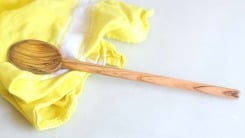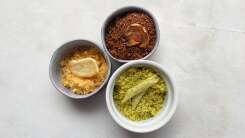How to Clean Your Filthy Pastry Brush
Pastry brushes are essential kitchen tools, even if you’re not much of a baker. In addition to applying egg (or mayo) washes to breads and pastries, you can use them to apply a slick sheen of mustard to a leg of lamb (to help the seasoning stick), baste a roast, or paint a whole chicken with mayonnaise. They do, however, get quite gunky.
While the silicone brushes are much easier to clean than their bristled counterparts, I greatly prefer the bristles. Silicone isn’t as good at grabbing on to fat or liquid and, while a silicone brush does a decent job slopping sauces onto large cuts of meat, it’s not-well suited for applying thin washes to delicate pastries, and tends to leave large, visible brush strokes.
The main advantage silicone brushes have over the traditional pastry brush is that you can chuck ‘em in the dishwasher. “Regular” wood handled brushes are cheap, however, and not that hard to clean. You just have to do it by hand, and make sure you dry the brush properly.

How to clean a pastry brush
Start by wiping off any congealed fat or gunk with a paper towel. Fat is the enemy of plumbing, so remove as much as you can and toss the dirty towels into the compost or trash.
Next, grab a small bowl or coffee mug and add a healthy squirt of dish soap. Fill it with water, then mash and swirl the bristles around in the bowl. Rinse and repeat if the bristles still feel sticky.
Scrub the handle (and the part where the bristles meet the handle), then rinse again. Work your fingers through the bristles as you rinse to make sure soap isn’t hiding at the base.
Now you must dry. Leaving a brush damp can cause discoloration and/or warping in the wood, and (potentially) mold in the bristle and handle. Blot the bristles with a clean kitchen towel, and lay them on a dish rack to dry fully. The Kitchn recommends leaving your brush in salt overnight to absorb any lingering moisture (salt is naturally hygroscopic), but you can also blast it with a hair dryer (my preferred method).
If you notice your brush is starting to lose bristles, or smell weird, or—in spite of your best efforts—you start to see a little mold, toss it and buy a new one. (They’re like three bucks at the restaurant supply store.)
RECOMMENDED NEWS

You Need a Dedicated Garlic Spoon
With the notable exception of my fish spatula, nearly all of my favorite spoons and turners are made...

Make Versatile Veggie Powders Out of Freeze-Dried Vegetables
Recently, I have been very into the various freeze dried vegetables available for purchase at Trader...

How to Make Perfect Mashed Potatoes in the Microwave
Mashed potatoes are as involved as you want them to be. Want to peel them? Great. Want to rice them?...

Life Is Better With These Cinnamon Corn Cookies
With all the savory odes-to-corn out in the world, I thought it was time to lengthen the dessert lis...

How to Remember the Difference Between Baking Powder and Baking Soda
Baking soda and baking powder are both chemical leavening agents that give height to baked goods thr...

Get a Cheap Thrill With Sweetened Cream Cheese
Due to a single misstep that resulted in shattering my left ankle, I have been staying with my paren...
Comments on "How to Clean Your Filthy Pastry Brush" :